springboot通过注解实现多线程
1、springboot启动类中添加 @enableasync
package com.zr.gktjweb;
import org.springframework.boot.springapplication;
import org.springframework.boot.autoconfigure.springbootapplication;
import org.springframework.scheduling.annotation.enableasync;
@springbootapplication
@enableasync
public class gktjwebapplication {
public static void main(string[] args) {
springapplication.run(gktjwebapplication.class, args);
}
}
2、在调用类之外的另一个类方法中添加
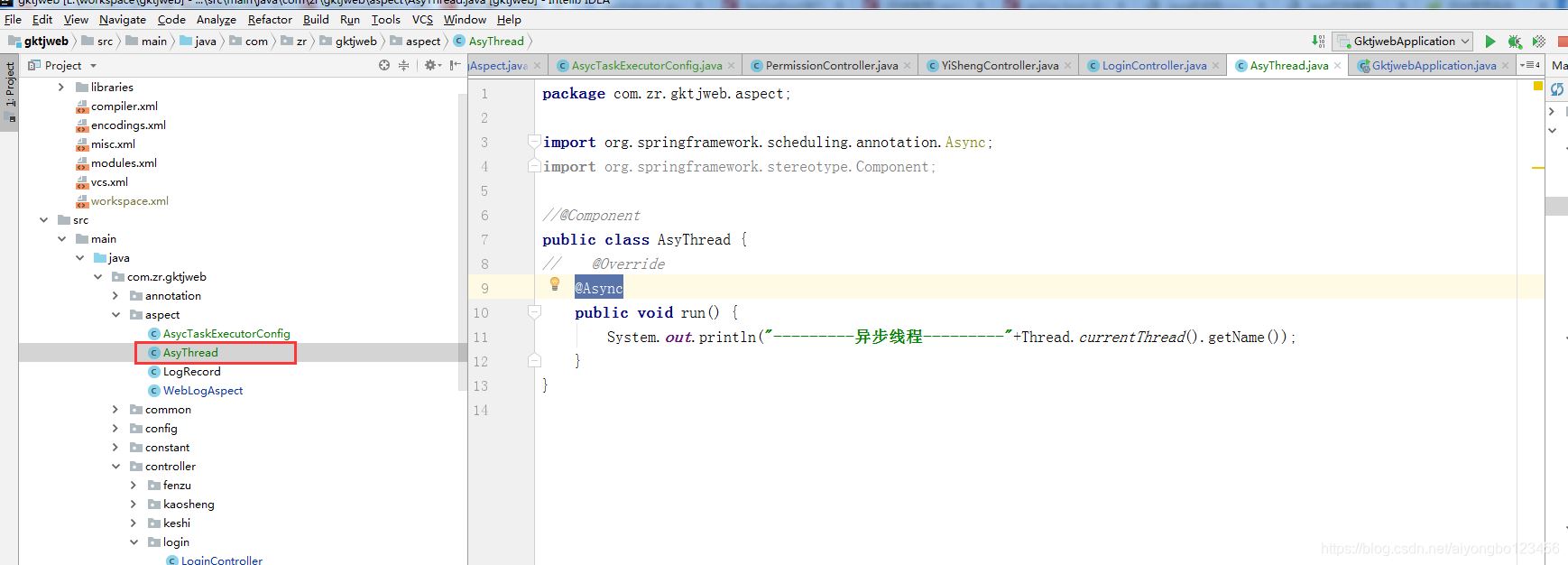
package com.zr.gktjweb.aspect;
import org.springframework.scheduling.annotation.async;
import org.springframework.stereotype.component;
//@component
public class asythread {
// @override
@async
public void run() {
system.out.println("---------异步线程---------"+thread.currentthread().getname());
}
}3、在另一个类中调用此方法
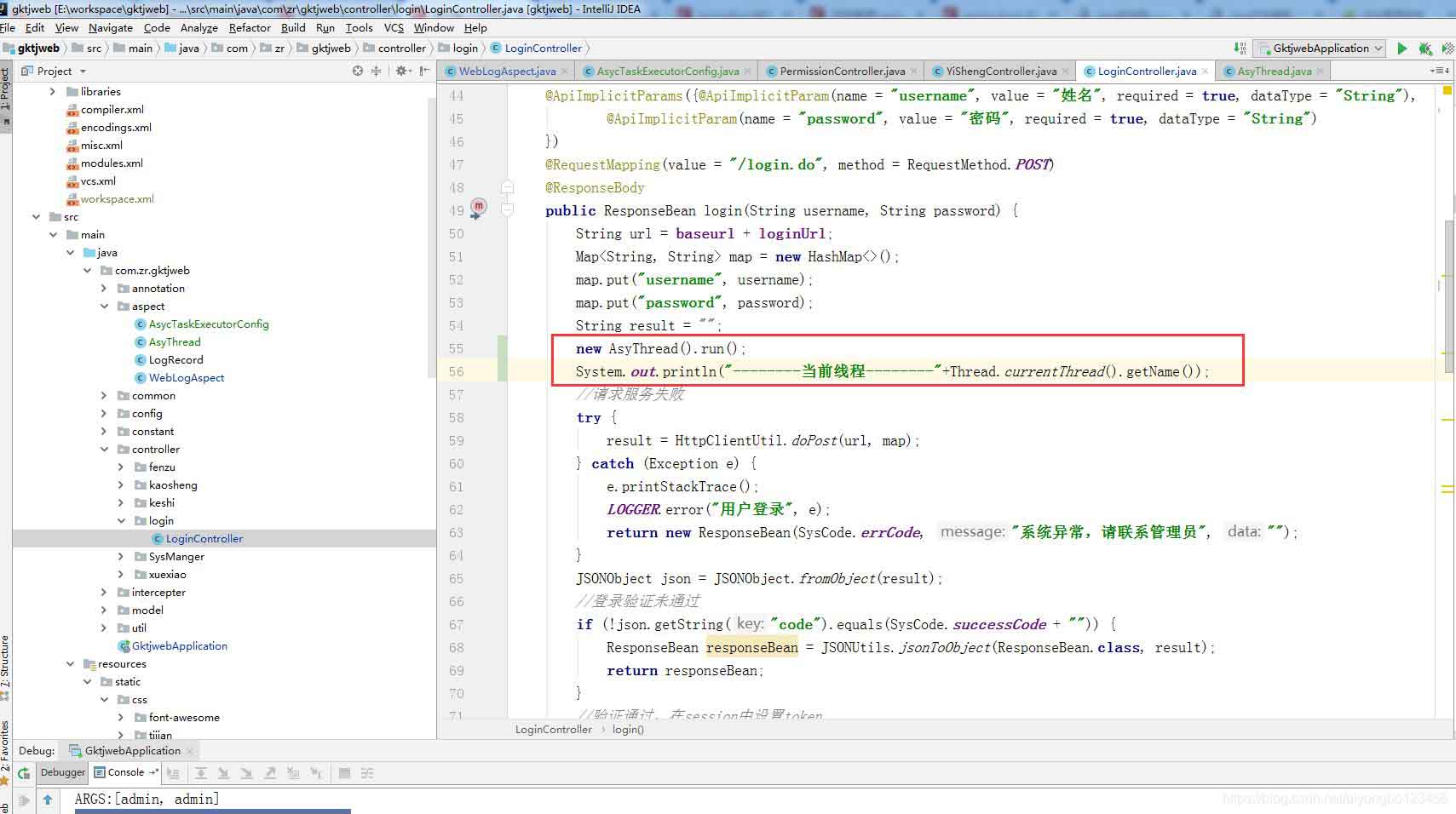
package com.zr.gktjweb.controller.login;
import com.zr.gktjweb.aspect.asythread;
import com.zr.gktjweb.common.httpclientutil;
import com.zr.gktjweb.common.responsebean;
import com.zr.gktjweb.constant.syscode;
import com.zr.gktjweb.model.sysuser;
import com.zr.gktjweb.util.comutil;
import com.zr.gktjweb.util.jsonutils;
import com.zr.gktjweb.util.userutil;
import io.swagger.annotations.api;
import io.swagger.annotations.apiimplicitparam;
import io.swagger.annotations.apiimplicitparams;
import io.swagger.annotations.apioperation;
import net.sf.json.jsonobject;
import org.slf4j.logger;
import org.slf4j.loggerfactory;
import org.springframework.beans.factory.annotation.value;
import org.springframework.stereotype.controller;
import org.springframework.web.bind.annotation.*;
import javax.servlet.http.httpservletrequest;
import java.util.hashmap;
import java.util.map;
@api(tags = "登录")
@controller
public class logincontroller {
@value("${baseurl}")
private string baseurl;
@value("${login_url}")
private string loginurl;
@value("${logout_url}")
private string logouturl;
@value("${syslogin_url}")
private string sysloginurl;
@value("${updateusersessionbyusername_url}")
private string updateusersessionbyusernameurl;
@value("${updatepass_url}")
private string updatepassurl;
private static final logger logger = loggerfactory.getlogger(logincontroller.class);
@apioperation(value = "登录", notes = "登录验证")
@apiimplicitparams({@apiimplicitparam(name = "username", value = "姓名", required = true, datatype = "string"),
@apiimplicitparam(name = "password", value = "密码", required = true, datatype = "string")
})
@requestmapping(value = "/login.do", method = requestmethod.post)
@responsebody
public responsebean login(string username, string password) {
string url = baseurl + loginurl;
map<string, string> map = new hashmap<>();
map.put("username", username);
map.put("password", password);
string result = "";
new asythread().run();
system.out.println("--------当前线程--------"+thread.currentthread().getname());
//请求服务失败
try {
result = httpclientutil.dopost(url, map);
} catch (exception e) {
e.printstacktrace();
logger.error("用户登录", e);
return new responsebean(syscode.errcode, "系统异常,请联系管理员", "");
}
jsonobject json = jsonobject.fromobject(result);
//登录验证未通过
if (!json.getstring("code").equals(syscode.successcode + "")) {
responsebean responsebean = jsonutils.jsontoobject(responsebean.class, result);
return responsebean;
}
//验证通过,在session中设置token
jsonobject datajson = (jsonobject) json.get("data");
string userjson = datajson.getstring("user");
sysuser sysuser = jsonutils.jsontoobject(sysuser.class, userjson);
jsonobject tokenjson = (jsonobject) datajson.get("token");
string token = tokenjson.getstring("token");
userutil.settoken(token);
userutil.setusersession(sysuser);
//第一次登陆修改密码
if(comutil.isempty(sysuser.getlastlogindate())){
return new responsebean(syscode.retpwdcode, "", "");
}
string url1 = "/index.html";
map<string, object> resmap = new hashmap<>();
resmap.put("url", url1);
return new responsebean(syscode.successcode, "登录成功", resmap);
}
/**
* 注销登录
*
* @param request
* @return
*/
@requestmapping("/loginout.do")
public string loginout(httpservletrequest request) {
request.getsession().invalidate();
string url=baseurl+logouturl;
httpclientutil.doget(url);
return "redirect:/";
}
@postmapping("/users/updatepass.do")
@apioperation(value = "修改密码")
@responsebody
public responsebean changepassword(string username, string oldpassword, string newpassword) {
string url = baseurl + updatepassurl;
map<string, string> map = new hashmap<>();
map.put("username", username);
map.put("oldpassword", oldpassword);
map.put("newpassword", newpassword);
string result = httpclientutil.dopost(url, map);
responsebean responsebean = jsonutils.jsontoobject(responsebean.class, result);
//修改密码后重新登录
responsebean loginresult=login(username,newpassword);
//登录验证未通过
if (!loginresult.getcode().tostring().equals(syscode.successcode + "")) {
return loginresult;
}
return responsebean;
}
@apioperation(value = "当前登录用户")
@getmapping("/sys/login.do")
@responsebody
public sysuser getlogininfo() {
return userutil.getcurrentuser();
}
}调用controller层后结果如下:
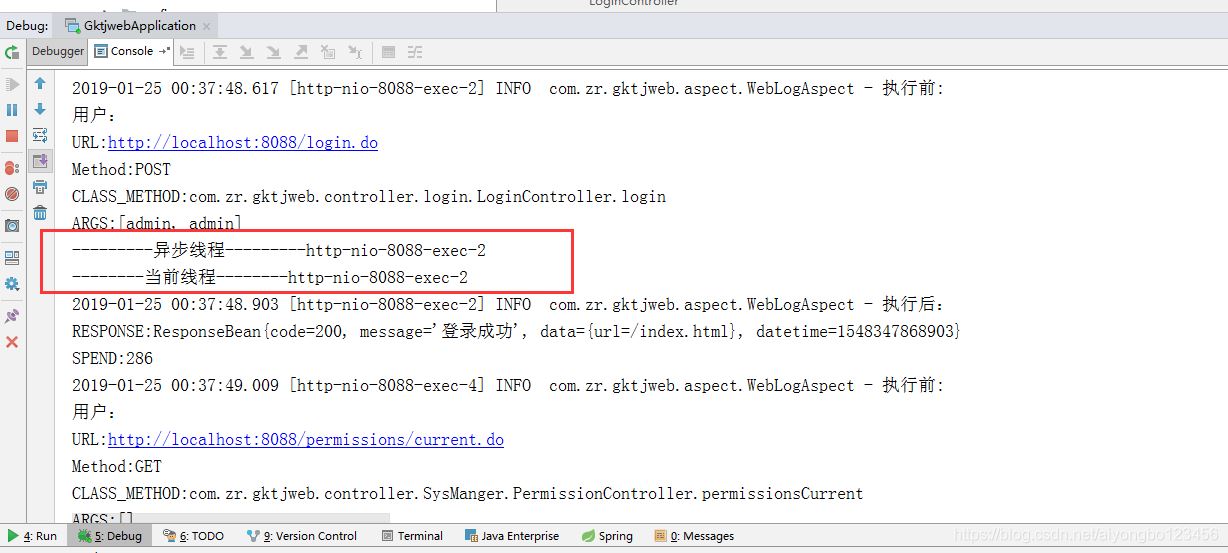
实现异步失败。
5、后改为将实现异步的类
注入到controller层。通过spring生成的bean来调用异步方法:
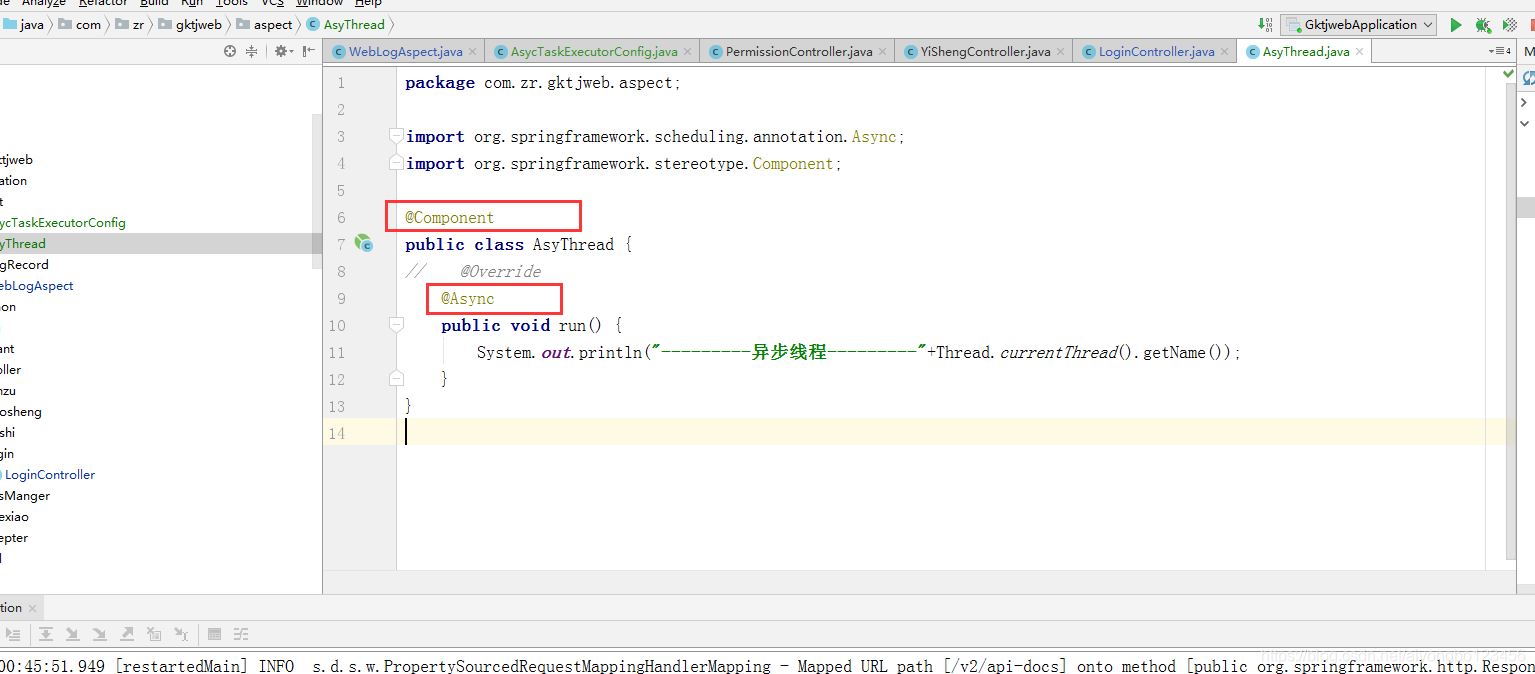
package com.zr.gktjweb.aspect;
import org.springframework.scheduling.annotation.async;
import org.springframework.stereotype.component;
@component
public class asythread {
// @override
@async
public void run() {
system.out.println("---------异步线程---------"+thread.currentthread().getname());
}
}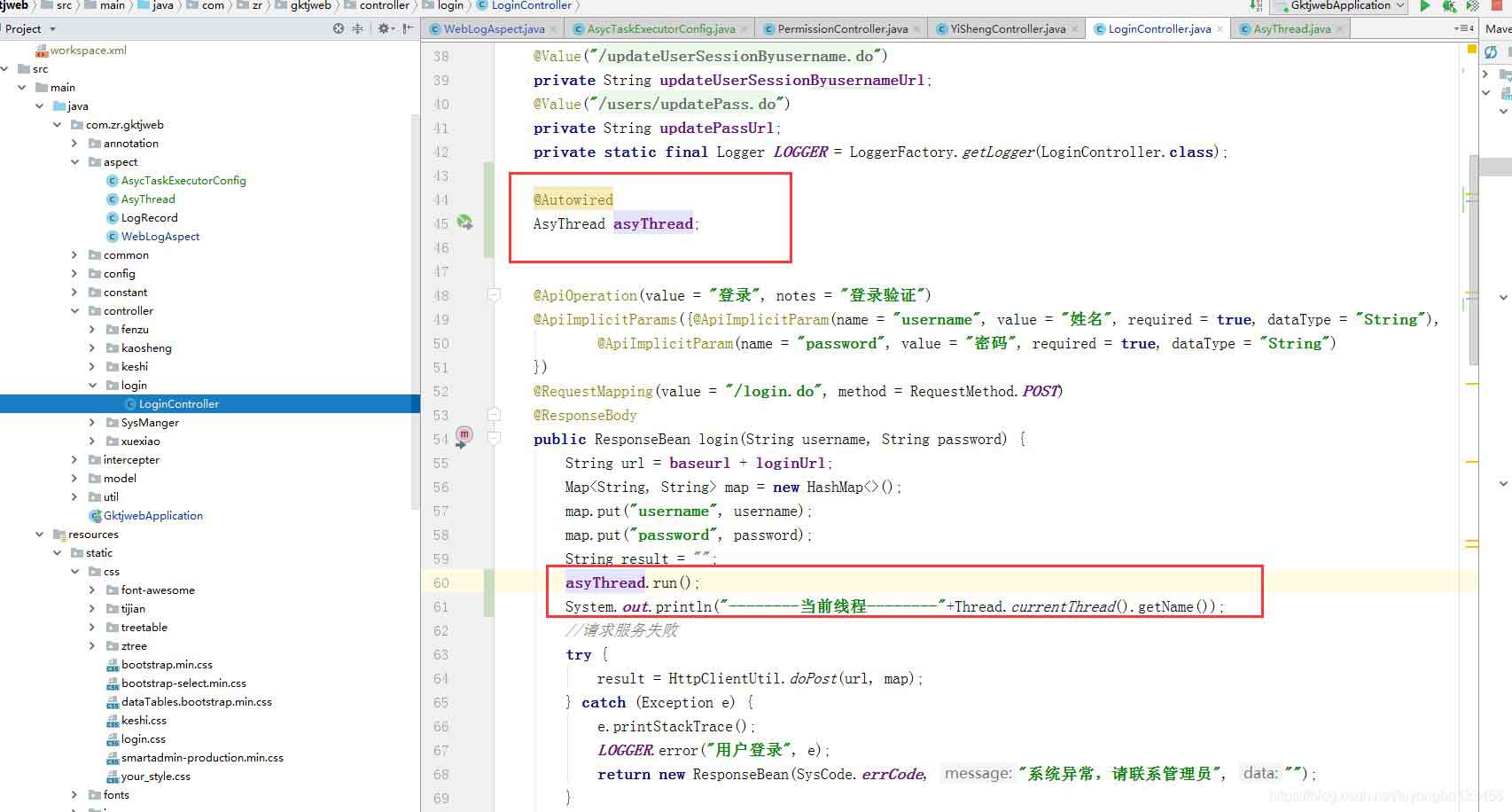
package com.zr.gktjweb.controller.login;
import com.zr.gktjweb.aspect.asythread;
import com.zr.gktjweb.common.httpclientutil;
import com.zr.gktjweb.common.responsebean;
import com.zr.gktjweb.constant.syscode;
import com.zr.gktjweb.model.sysuser;
import com.zr.gktjweb.util.comutil;
import com.zr.gktjweb.util.jsonutils;
import com.zr.gktjweb.util.userutil;
import io.swagger.annotations.api;
import io.swagger.annotations.apiimplicitparam;
import io.swagger.annotations.apiimplicitparams;
import io.swagger.annotations.apioperation;
import net.sf.json.jsonobject;
import org.slf4j.logger;
import org.slf4j.loggerfactory;
import org.springframework.beans.factory.annotation.autowired;
import org.springframework.beans.factory.annotation.value;
import org.springframework.stereotype.controller;
import org.springframework.web.bind.annotation.*;
import javax.servlet.http.httpservletrequest;
import java.util.hashmap;
import java.util.map;
@api(tags = "登录")
@controller
public class logincontroller {
@value("${baseurl}")
private string baseurl;
@value("${login_url}")
private string loginurl;
@value("${logout_url}")
private string logouturl;
@value("${syslogin_url}")
private string sysloginurl;
@value("${updateusersessionbyusername_url}")
private string updateusersessionbyusernameurl;
@value("${updatepass_url}")
private string updatepassurl;
private static final logger logger = loggerfactory.getlogger(logincontroller.class);
@autowired
asythread asythread;
@apioperation(value = "登录", notes = "登录验证")
@apiimplicitparams({@apiimplicitparam(name = "username", value = "姓名", required = true, datatype = "string"),
@apiimplicitparam(name = "password", value = "密码", required = true, datatype = "string")
})
@requestmapping(value = "/login.do", method = requestmethod.post)
@responsebody
public responsebean login(string username, string password) {
string url = baseurl + loginurl;
map<string, string> map = new hashmap<>();
map.put("username", username);
map.put("password", password);
string result = "";
asythread.run();
system.out.println("--------当前线程--------"+thread.currentthread().getname());
//请求服务失败
try {
result = httpclientutil.dopost(url, map);
} catch (exception e) {
e.printstacktrace();
logger.error("用户登录", e);
return new responsebean(syscode.errcode, "系统异常,请联系管理员", "");
}
jsonobject json = jsonobject.fromobject(result);
//登录验证未通过
if (!json.getstring("code").equals(syscode.successcode + "")) {
responsebean responsebean = jsonutils.jsontoobject(responsebean.class, result);
return responsebean;
}
//验证通过,在session中设置token
jsonobject datajson = (jsonobject) json.get("data");
string userjson = datajson.getstring("user");
sysuser sysuser = jsonutils.jsontoobject(sysuser.class, userjson);
jsonobject tokenjson = (jsonobject) datajson.get("token");
string token = tokenjson.getstring("token");
userutil.settoken(token);
userutil.setusersession(sysuser);
//第一次登陆修改密码
if(comutil.isempty(sysuser.getlastlogindate())){
return new responsebean(syscode.retpwdcode, "", "");
}
string url1 = "/index.html";
map<string, object> resmap = new hashmap<>();
resmap.put("url", url1);
return new responsebean(syscode.successcode, "登录成功", resmap);
}
/**
* 注销登录
*
* @param request
* @return
*/
@requestmapping("/loginout.do")
public string loginout(httpservletrequest request) {
request.getsession().invalidate();
string url=baseurl+logouturl;
httpclientutil.doget(url);
return "redirect:/";
}
@postmapping("/users/updatepass.do")
@apioperation(value = "修改密码")
@responsebody
public responsebean changepassword(string username, string oldpassword, string newpassword) {
string url = baseurl + updatepassurl;
map<string, string> map = new hashmap<>();
map.put("username", username);
map.put("oldpassword", oldpassword);
map.put("newpassword", newpassword);
string result = httpclientutil.dopost(url, map);
responsebean responsebean = jsonutils.jsontoobject(responsebean.class, result);
//修改密码后重新登录
responsebean loginresult=login(username,newpassword);
//登录验证未通过
if (!loginresult.getcode().tostring().equals(syscode.successcode + "")) {
return loginresult;
}
return responsebean;
}
@apioperation(value = "当前登录用户")
@getmapping("/sys/login.do")
@responsebody
public sysuser getlogininfo() {
return userutil.getcurrentuser();
}
}访问contrller层后,结果如下:
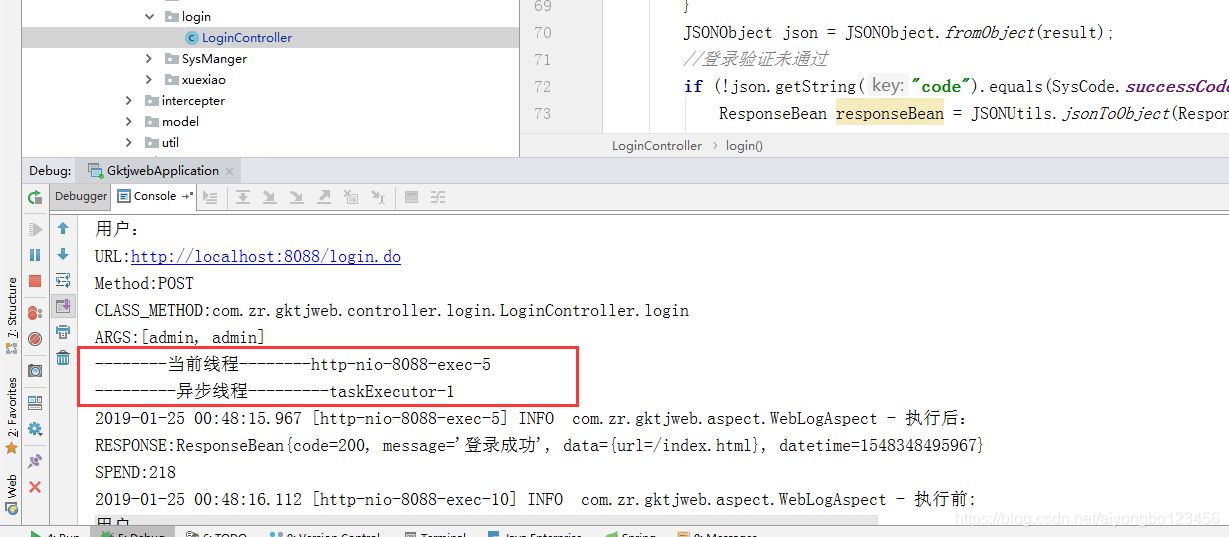
成功实现异步。
总结
以上为个人经验,希望能给大家一个参考,也希望大家多多支持代码网。






发表评论